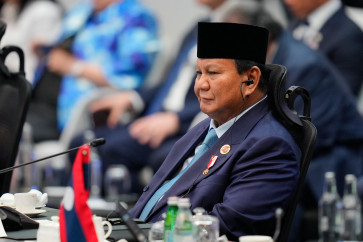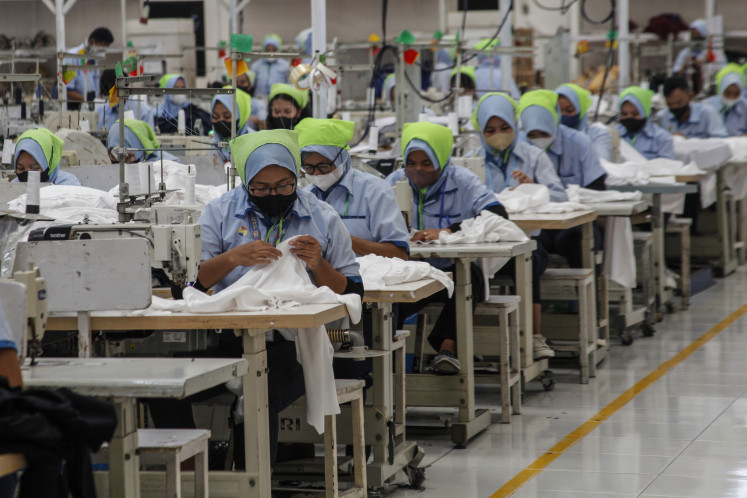Popular Reads
Top Results
Can't find what you're looking for?
View all search resultsPopular Reads
Top Results
Can't find what you're looking for?
View all search resultsDenmark on the making of young blood in badminton
Aiming to rejuvenate its elite shuttlers, Denmark is upbeat about its newly installed athlete development program, aiming for higher achievement in the international badminton arena
Change text size
Gift Premium Articles
to Anyone
A
iming to rejuvenate its elite shuttlers, Denmark is upbeat about its newly installed athlete development program, aiming for higher achievement in the international badminton arena.
Similar to Indonesia’s drought of young blood and long-term dependence on veteran Taufik Hidayat, for more than a decade, Denmark has been relying on its current world number two men’s singles ace Peter Gade and other players who a part of the veteran group.
Fully aware of its athlete-regeneration issue, five years ago, the Badminton Association of Denmark (BAD) initiated a development program right at the country’s sports core: clubs.
The program, called the Badminton Age-related Training Concept (BATK) includes a training scheme focusing more hours on physical and strength drilling, junior grading systems through year-round local tournaments and one-on-one coaching sessions.
Seven badminton clubs out of the 560 scattered around the small Scandinavian country served as pilot projects to introduce the BATK framework to the nation of 5 million.
The youth development scheme might be regarded as novel among clubs in Denmark that do not
have any systematic training programs. Clubs there have both junior and senior players, many of who only play socially.
“We have increased the number of training hours and amount of physical training required for young players to enter the elite junior program. Once all the clubs have adjusted to that, we will see in the long run if we can produce players closer to those from China, Malaysia and Indonesia,” BAD’s manager of talent development Bo Omosegaard said recently at the Denmark Open in Odense.
Omosegaard was thrilled with the blossoming young Danish shuttlers after the implementation of the five-year-old talent development program.
“We had tremendous success at the World Junior Championship in Mexico this year. Those players coming up now are the first generation to have been introduced to the program, when they were in the U15s or second year U17s,” he said. BAD currently supports 100 to 120 Danish players of U13s (45 players), U15s (35), U17s (22) and U19s (16).
At April’s World Junior Championship in Guadalajara, Mexico, 16-year-old Dane Viktor Axelsen came out as world junior champ after beating South Korean young gun Kang Ji-wook. Axelsen is the first European shuttler to ever win the title in the men’s singles. In 1994, Gade, who is now 33, was the world junior champ in the men’s doubles.
In Mexico, young Danish pair Sandra Maria Jensen and Line Kjaersfeldt were left standing in the women’s doubles semifinals, while Kim Astrup and Rasmus Fladberg were in the men’s doubles semis. Their feats surpassed Indonesia’s, whose best result was from Riyanto Subagja, who stayed at the bottom of the men’s singles top eight.
Badminton coach Lennart Engler, who trains Axelsen at the OBK (Odense Badminton Club), one of the seven pilot clubs, highlighted the benefits of more exposure in international tourneys for young Danes.
“If [the youngsters] don’t play internationally, they don’t get the experience. They need to learn to play against Asian players,” said Engler, whose club supports its talent to compete in European Union tournaments and joined trainings in China for the past two years.
“If we have a system like that in Asia, I think that our players will be better earlier,” he said, quickly adding that the systematic training approach applied by badminton powerhouse China must be modified, when it is brought to Danish soil to best suit the European culture, which puts democracy above all.
“The Danes relate to badminton emotionally. We have to always make training fun. If we conduct training exactly like in China where you have to do one stroke for 10 minutes, another stroke for another 10 minutes, we would not have any players left, it will become too boring,” said Engler.
Letting children enjoy the fun of sports as early as possible is also a core principle upheld by some public schools that also support for the sports development programs, whether badminton or the country’s other favorites: soccer, handball, volleyball, ice hockey, table tennis and swimming.
“It’s important that everyday is [seen as] sports day. That’s why the sports hall is always open,” said vice principal of Hjallese public school Keld Gantzhorn.
“[To] students who misbehave, I give them a ball and tell them: ‘You should not do bad things to your classmates. Go out and play ball instead of being a fool’,” Gantzhorn said.
Hjallese was the first public school to engage in sport talent development by providing eighth to 10th graders who are gifted in sports more time to train at clubs, without neglecting their academic subjects. In 2004, Team Denmark, a body funded by the cultural ministry and sponsors, introduced the approach nation-wide in 40 schools, which included 8,531 students in 18 counties.
As of today, 16-year-old shuttler Axelsen and 18-year-old Ajax Amsterdam midfielder Christian Eriksen, to name a few, are young bloods born of the program.










